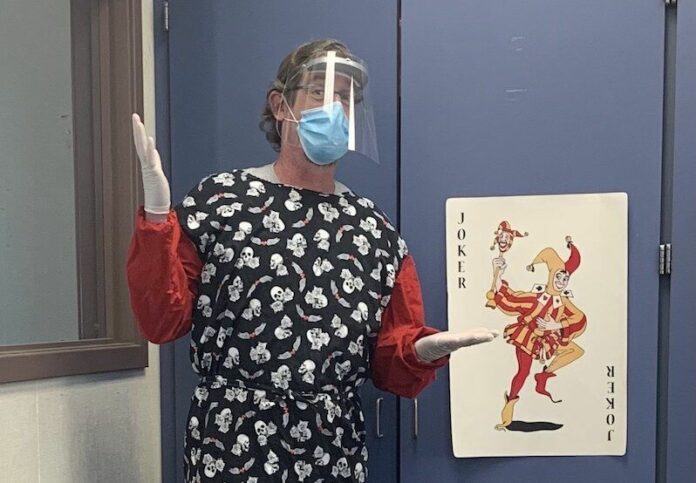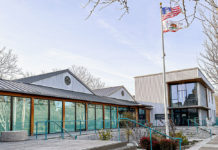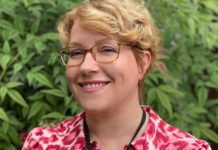West county teacher Adam Alcorn welcomed back West Sonoma County Union High School District’s first student cohort to return to campus for in-person instruction last week.
Superintendent Toni Beal confirmed Alcorn’s group was the first, though the district has had learning pods at its three high schools for students needing internet access.
As of Feb. 22, Alcorn teaches the Severely Handicapped Special Day Class (SHSDC) in a hybrid format, simultaneously instructing four students on the Analy High School campus and three others logging into Zoom and Google Classroom from home as the class had done since last March, when schools first shut down for the COVID-19 pandemic.
“It’s great to see the kids back in the classroom. I just love it. It’s also exhausting,” he said. “The hybrid part of it, splitting your attention between in-person students and students online is more challenging than I thought it would be. But the kids who are coming to the classroom are certainly enjoying it.”
Preparations to reopen the classroom began after the California Department of Public Health updated its guidance related to cohorts for students with high needs last September, said Rose Velasquez, director of the West Sonoma County Consortium.
The consortium serves west county students with moderate to severe disabilities from preschool to 12th grade, normally in classrooms across west county districts, Velasquez said. Alcorn is the consortium’s high school educator, teaching local ninth through 12th graders with moderate to more intense intellectual, physical and emotional disabilities, he said.
Velasquez said Alcorn was eager to provide in-person learning for his students, so the consortium met with superintendents, parents, nurses, speech pathologists, West Sonoma County Teachers’ Association and West County Transportation to determine how to bring a small cohort back safely.
“It took a lot of work,” she said, including a safety training for parents and a pledge to comply with Centers for Disease Control and Prevention guidelines. Alcorn said he recently received his second COVID-19 vaccination.
Velasquez said the small cohort plan they created also accounts for maintaining proper air filtration, social distancing, Plexiglas, drop-off and pick-up, personal supplies for each student and specialized protocols for a range of potential circumstances across the consortium’s classrooms, like medication, feeding, toileting and seizures, as well as the face shields, gowns and aprons sometimes required.
Parents express relief and apprehension around COVID-19
Sydney Barragan praised Alcorn, Velasquez and the classroom’s reopening after challenging months supporting her nonverbal and autistic son through distance learning.
“But sending him to school has been great. I’ve noticed a change in Sergio’s happiness overall, he’s excited to go to school every day, which is great,” she said.
Barragan said restoring normalcy made a big difference because her son is very schedule-oriented.
“When that got taken away from him, he became irregular and his whole shift of attitude changed. So, it’s like night and day almost. He’s back to his own self,” she said.
Now that Sergio gets to engage with other students, he’s also learning to maintain social distance, “which is awesome,” Barragan said. “They’re teaching him, ‘Okay, you have to keep your social distance, you have to wash your hands and do the right thing,’ and I think that’s also helpful in his situation because they’re teaching him, as well as we’re teaching him at home, that you have to stay safe, basically.”
At home, Barragan said she or her son’s dad needed to sit beside him at all times to prompt him when he was in online class because he had a hard time concentrating and comprehending what was on the screen, associating his environment with home, not school.
Barragan said her family moved all the way from Illinois in 2019 to get Sergio the resources he needs because applied behavioral analysis wasn’t considered a medical necessity in Chicago, where advocating for her son was a struggle.
“You have to understand that I came from fighting for Sergio with IEPs (individualized education plans) every year in Illinois, having to do all this until I was blue in the face and then finally, it’s almost like a relief, like I can release and let go and be like ‘Wow, these people really get it. They understand what it means to help children on the spectrum or help children with special needs,’” she said.
The choice to send high schoolers back to campus or not was a difficult one for families because “parents had to balance the benefits of in-person instruction with the weight of guarding the health of their children,” many of whom have health complications to consider, Velasquez said.
“These difficult decisions are so much more important than mere numbers. They reflect real family struggles,” she said.
Suzanne Solorio said she’s happy for her son because he’s excited to go back to school, but that she couldn’t help but feel nervous about his increased exposure to COVID-19.
Her son, Daniel, is a senior in high school and has a rare genetic condition known as Coffin Lowry Syndrome, she said. Helping Daniel and her other children stay focused on their lessons in the home environment was difficult, Solorio said. The transition back to class went well, she said, other than some reluctance to wear a mask he doesn’t normally need to wear because their family doesn’t have much outside contact.
Nonetheless, Solorio spoke highly of the way Alcorn and west county services have met his needs, like shorter Zoom classes throughout the day that are more optimal for Daniel to stay concentrated. Alcorn kept the lessons entertaining, she said.
“He did videos from the very beginning to explain what was going on and he made them fun and interactive, so Daniel would love going back and watching the videos,” she said. “He still watches the videos that Adam made from the very beginning, so that was kind of fun, to watch him be interested in what’s coming next.”
When class is in session
Class runs from about 8 a.m. to 12:30 p.m. Monday, Tuesday, Thursday and Friday, focusing on functional independent living skills and functional academic skills, like reading and writing, Alcorn said. This last Monday, students participated in a lesson on grocery shopping and dollar and cents amounts, he said.
While distance learning is rough for just about everyone, Alcorn said the learning loss can be much more drastic for his students who especially need more hands-on learning, relationship-building experiences and structure to maintain a learning pace that is slower than their peers.
“It’s so great to be able to make eye contact with the kids not through a screen, and I think even simple things like that, being able to make eye contact with the kids, the kids being able to make eye contact with each other, I can tell has made a difference,” Alcorn said.
Alcorn added that even after one week, he noticed students interacting more with each other and a growing willingness to build relationships with each other and staff that they need to develop their capacities and that was so challenging to bring about on Zoom.
However, he said he also noticed some learning loss in at least one student’s independent living skills and readiness to engage in activities upon the return after a year of distance learning.
“I haven’t been there, pushing and doing my job with them in person, so I would say I’m just trying to get the kids back to that level of eagerness to participate in the classroom,” he said.
Reading students in person makes it much more possible to tell whether the students are grasping the material, Alcorn said.
This is particularly meaningful because three of the four students in the classroom he had never met in person before, so the only reference he had to assess their progress was the IEP document prepared by the student’s previous special education teacher, he said.
After a morning symptom survey by parents, a temperature check and handwashing, with masks all around, Alcorn visually unites students at home with those in the room, seated six feet apart.
With the help of the WSCUHSD’s technology department, the gallery of students following along on Zoom are shown from a big screen TV while Alcorn also projects a lesson onto the whiteboard so students physically present can take a break from their Chromebooks, he said.
“That was really important for me. I wanted the kids at home to be able to be seen by the kids in the classroom to really help continue to build that sense of community and relational learning,” Alcorn said.
“I got some really hard-working parents in my class who have been put on the spot, essentially, with the school closures,” he said, as some parents would sit beside their child during class to support them. “And the parents in my class have just been doing an amazing job of doing what they can to help me, really, see that their kids are getting the best education that is possible at this time.”
For students attending in person, two consortium staff aides also chose to return to assist students, according to Alcorn.
According to Velasquez, the small cohort plan requires more specific protocols than a typical school reopening and refers to the district’s COVID-19 Prevention Plan but does not need to do so. However, SHSDC will need to adapt to the district’s guidelines if WSCUHSD reopens under their required framework, she said.
Velasquez said she expects the SHSDC cohort to continue for the rest of the school year, only to shut down in the event of a COVID-19 outbreak as directed by the local government.
59.6
F
Healdsburg
April 18, 2025








